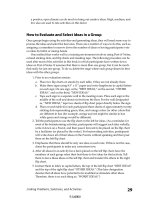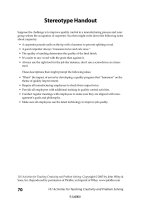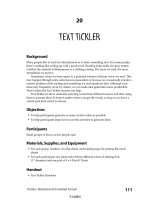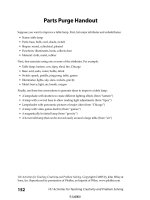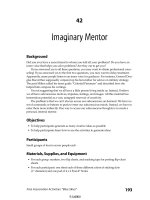Decision making and problem solving strategies MANTESH
Bạn đang xem bản rút gọn của tài liệu. Xem và tải ngay bản đầy đủ của tài liệu tại đây (11.74 MB, 106 trang )
Decision Making
and
Problem Solving
Strategies
THIS PAGE INTENTIONALLY
LEFT BLANK
Decision Making
and
Problem Solving
Strategies
John Adair
Publisher’s note
Every possible effort has been made to ensure that the information contained in
this book is accurate at the time of going to press, and the publishers and author
cannot accept responsibility for any errors or omissions, however caused. No
responsibility for loss or damage occasioned to any person acting, or refraining
from action, as a result of the material in this publication can be accepted by the
editor, the publisher or the author.
Previously published by the Institute of Personnel and Development as Decision
Making and Problem Solving 1997 and 1999
First published in Great Britain and the United States in 2007 by Kogan Page
Limited as Decision Making and Problem Solving Strategies
Reissued 2010
Apart from any fair dealing for the purposes of research or private study, or
criticism or review, as permitted under the Copyright, Designs and Patents Act
1988, this publication may only be reproduced, stored or transmitted, in any form
or by any means, with the prior permission in writing of the publishers, or in
the case of reprographic reproduction in accordance with the terms and licences
issued by the CLA. Enquiries concerning reproduction outside these terms should
be sent to the publishers at the undermentioned addresses:
525 South 4th Street, #241
120 Pentonville Road
Philadelphia pa 19147
London n1 9jn
United Kingdom
usa
www.koganpage.com
4737/23 Ansari Road
Daryaganj
New Delhi 110002
India
© John Adair, 1997, 1999, 2007, 2010
The right of John Adair to be identified as the author of this work has been
asserted by him in accordance with the Copyright, Designs and Patents Act 1988.
ISBN 978 0 7494 5551 4
E-ISBN 978 0 7494 5890 4
The views expressed in this book are those of the author, and are not necessarily
the same as those of Times Newspapers Ltd.
British Library Cataloguing-in-Publication Data
A CIP record for this book is available from the British Library.
Library of Congress Cataloging-in-Publication Data
Adair, John.
Decision making and problem solving strategies / John Adair. -- 2nd.
ed.
p. cm.
Originally published in 2007.
Includes index
ISBN 978-0-7494-5551-4 -- ISBN 978-0-7494-5890-4
(ebook) 1. Decision making. 2. Problem solving. 3. Thought and
thinking. I. Title. II. Title: Decision making and problem solving
strategies.
HD30.23.A3 2010
658.4’03--dc22
Typeset by Jean Cussons Typesetting, Diss, Norfolk
Printed and bound in India by Replika Press Pvt Ltd
2009031517
Contents
About the author vii
Introduction 1
1 Your mind at work 3
Is your brain working now? 4; The functions
of the mind 6; Introducing the Depth Mind
principle 12; Key points 15
2 The art of effective decision making 17
Define the objective 18; Collect relevant
information 18; Generate feasible options 21;
Make the decision 23; Implement and evaluate 28;
Key points 31
3 Sharing decisions with others 35
Your role as leader 35; Task need 36; Team
maintenance need 36; Individual needs 37;
The three circles interact 38; The functions of
leadership 38; Key points 44
vi Contents
4 Key problem-solving strategies 45
How problems differ from decisions 45; A unified
model for decision making and problem solving 47;
Asking the right questions 48; How to approach
systems problems 50; Key points 53
5 How to generate ideas 56
Brainstorming 56; Guidelines for brainstorming 57;
How to run a brainstorming session 59; Key points 61
6 Thinking outside the box 63
Towards a more creative approach 63; Look
wider for solutions 65; How to use your
Depth Mind 67; The creative thinking process 69;
Mental roadblocks 70; Key points 72
7 Developing your thinking skills 75
What is an effective practical thinker? 75; Check
that you are in the right field 78; Key factors in
choosing your field of work 78; How to design
your own learning strategy 79; Key points 83
Appendix 85
Further reading 89
Index 91
About the author
John Adair is now widely regarded as the world’s leading
authority on leadership and leadership development. The
author of 30 books on the subject, he has been named as one
of the 40 people worldwide who have contributed most to the
development of management thought and practice.
Educated at St Paul’s School, John Adair has enjoyed a varied
and colourful career. He served as adjutant in a Bedouin regiment
in the Arab Legion, worked as a deckhand on an Arctic trawler
and had a spell as an orderly in a hospital operating theatre. After
attending Cambridge University he became Senior Lecturer in
Military History and Leadership Training Adviser at the Royal
Military Academy, Sandhurst, before becoming the first Director
of Studies at St George’s House in Windsor Castle and then
Associate Director of the Industrial Society. Later he became the
world’s first Professor in Leadership Studies at the University
of Surrey. He also helped to found Europe’s first Centre for
Leadership Studies at the University of Exeter.
John Adair now acts as a national and international adviser
on leadership development. His recent books, published by
Kogan Page, include Not Bosses But Leaders, The Inspirational
Leader, How to Grow Leaders and Leadership and Motivation.
THIS PAGE INTENTIONALLY
LEFT BLANK
Introduction
There are three forms of applied thinking that we all need:
decision making, problem solving and creative thinking. These
overlap considerably but they can be distinguished.
Decision making is about deciding what action to take; it
usually involves choice between options. The object of problem
solving is usually a solution, answer or conclusion. The outcome
of creative thinking, by contrast, is new ideas.
Any leader such as yourself who aspires to excellence
obviously has a vested interest in seeing that the best decisions
are taken, that problems are solved in the optimum way
and that the creative ideas and innovations so necessary for
tomorrow’s business flow freely. Of course, everyone in the team
or organisation should be engaged in meeting these essential
requirements. But you are the one who is called to provide the
intellectual leadership that is needed. Are you willing to do so?
One step towards that end that you should definitely
take is to become master of the processes of practical thinking,
the processes that lie behind all effective decision making,
problem solving and creative thinking. You cannot guarantee
outcomes – for luck or chance plays a part in all human affairs
2 Decision Making and Problem Solving Strategies
– but you can at least make sure that you use the well tried-andtested processes of thinking to some purpose. You own that
responsibility. For my part, the aim of this book is to equip you
with the necessary knowledge of those processes and to help you
to acquire skill in using them.
One further word. Forget the idea that thinking is somehow
a painful and laborious feeling in the mind, a kind of headache
that is best avoided if possible. Thinking is fun. By fun here I do
not really mean a diversion that affords enjoyment. For the word
also means an activity that engages one’s interest or imagination,
an activity that may prove to be more than a diversion and
may involve challenge and hard work but is still a source of
enjoyment. If you come to love thinking for yourself you will
learn naturally to do it well.
As Roy Thompson, one of the greatest businessmen of our
time, once said, ‘If I have any advice to pass on, as a successful
man, it is this: if one wants to be successful, one must think;
one must think until it hurts.’ He added that, ‘From my close
observation, I can say that there are few people indeed who are
prepared to perform this arduous and tiring work.’ Are you one of
them?
In the following pages we shall explore some practical ways
in which you can improve your skills in this key area. By the time
you have worked through the book you should:
• understand the way in which the mind works and the
principles of effective thinking;
• have a clear framework for decision making;
• be aware of the relation between decision making and
problem solving;
• be able to use a unified model for both making
decisions and solving problems;
• have sharpened up your creative thinking skills;
• be in a position to chart a way forwards for improving
your thinking skills across the board.
1
Your mind at work
Behind your practical, everyday thinking there lies the most
complex thing in the known universe: the human mind. Nobody
hires and pays you nowadays for your physical strength. You are
employed because you have a mind – and can use it effectively.
There is a vital distinction between brain and mind. Take a
computer as an analogy. Your brain is what you see if you open
up the back of the computer – all those chips and circuits –
whereas the mind is what appears dynamically on the screen. In
this book we are focusing on the mind, for that is accessible to us
without peering into the skull.
There are two aspects to the mind: the information it can
store in the memory, and what it can do. What we call technical
or professional knowledge usually involves both. You not only
need knowledge about a subject but you also need to be able to
apply it in a variety of unforeseen situations.
Such applications of professional knowledge invariably
involve the activities of decision making and problem solving.
A doctor, for example, is problem solving when he or she tries to
diagnose the cause of your weak left leg. Indeed, decision making
and problem solving are so bound up with particular kinds of
4 Decision Making and Problem Solving Strategies
information or knowledge – areas of professional competence –
that we find it hard to think of them in the abstract.
Are there any generic or transferable skills in these areas?
Yes, I believe there are. The characteristic function of the mind
is to think. So let’s leave on one side for a moment the memory
or database function of the mind and concentrate on its primary
role as a thinking tool. What is the nature of thinking? Are there
any universal principles? If so, how can you use these principles
to sharpen your skills as a practical thinker?
Is your brain working now?
The physical base of your mind is of course your brain, the grey
matter housed in your head. Your brain is composed of about
10,000 million cells. In fact it has more cells than there are
people on the face of the earth! Each one of those cells can link
up with approximately 10,000 of its neighbours, which gives you
some 1 plus 800 noughts of possible combinations.
Our potential brain power is known to be far greater than
the actual power it achieves. No one has remotely approached
the limits of it. One estimate suggests that we use no more than
about 10 per cent of our brain power. So don’t be worried by the
fact that you are losing about 400 brain cells every day – indeed,
if you do not exercise your mind throughout your life your brain
will shrink at a faster rate. Use it or lose it!
Before we go any further, I suggest we double-check that
all your 10,000 million brain cells are warmed up and working
properly by trying to solve some problems. Actually, the three
problems below require only about 3,000 million brain cells, so
they will not take long or cause us much delay!
Two other points before we begin. The three problems are not
just brain-teasers: they illustrate principles about thinking. So I
am not playing games with you. Second, I am not going to give
you the answers in this chapter to the first two problems, though
I shall do so later. This can be a bit frustrating. But I have a reason
5 Your Mind at Work
for leaving you in suspense. For reasons I shall explain later, I
believe that the answers to problems 1 and 2 – assuming that you
cannot solve them immediately – may come to you later.
Problem 1 The nine dots
Take a piece of paper larger than this page and put on it a pattern
of nine dots, like this:
●
●
●
●
●
●
●
●
●
Now connect up the dots by four straight consecutive lines (that
is, without taking your pen or pencil off the paper). You should be
able to complete this task within three minutes.
Problem 2 The six matchsticks
Place six matchsticks – preferably of the wooden variety – on
a flat surface. Now arrange the matchsticks in a pattern of four
equilateral (ie equal-sided) triangles. You may not break the
matchsticks – that is the only rule. Again, you should be able to
do it within three minutes. There are at least two solutions, but I
want the best one.
Problem 3 Who owns the zebra?
Having got the two easy ones safely behind you – well done if you
have solved both those problems – we come now to something
6 Decision Making and Problem Solving Strategies
a little more demanding, so you must call up your reserve brain
cells.
The world record for solving both parts of this problem is 10
minutes. So I will give you 30 minutes which, I am sure you will
agree, is overgenerous of me!
1 There are five houses, each with a front door of a different
colour, and inhabited by people of different nationalities,
with different pets and drinks. Each person eats a
different kind of food.
2 The Australian lives in the house with the red door.
3 The Italian owns the dog.
4 Coffee is drunk in the house with the green door.
5 The Ukrainian drinks tea.
6 The house with the green door is immediately to the right
(your right) of the house with the ivory door.
7 The mushroom-eater owns snails.
8 Apples are eaten in the house with the yellow door.
9 Milk is drunk in the middle house.
10 The Norwegian lives in the first house on the left.
11 The person who eats onions lives in the house next to the
person with the fox.
12 Apples are eaten in the house next to the house where the
horse is kept.
13 The cake-eater drinks orange juice.
14 The Japanese eats bananas.
15 The Norwegian lives next to the house with the blue door.
Now, who drinks water and who owns the zebra?
The functions of the mind
Let’s now look at how the mind works. I suggest that there are
three main functions: analysing, synthesising and imagining,
and valuing.
7 Your Mind at Work
ANALYSING
SYNTHESISING
VALUING
Figure 1.1 The main functions of the mind
In the applied forms of effective thinking – decision making,
problem solving, and creative or innovative thinking – all three
of these functions are at work. It is their underlying health that
largely determines the quality of your thought. Few people have
them in harmonious balance, as shown in the illustration above.
Most of us are better at one rather than the other two.
Our differing mental strengths are a powerful reason why
we need each other: effective thinking in all its forms is both
a solitary and a social activity. You should always see yourself
alternately as thinking alone (for yourself) and as thinking with
others – either face to face or, as in this case, by reading or some
other method of communication. Still, it is a good idea to seek
to develop your skills in the weaker areas, like a person building
up muscles in a limb through exercise: you will not always have
the right people at hand to correct your bias towards a particular
function.
8 Decision Making and Problem Solving Strategies
Analysing
The word ‘analyse’ comes from a Greek verb meaning ‘to loosen’,
and it means separating a whole into its constituent parts. In
tackling the ‘Who owns the zebra?’ exercise you were using your
analytical skills of dissection, trying to break down the task into
its parts.
Analytical thinking is closely related to logical or step-bystep reasoning. You may have noticed that one of the skills you
were using in tackling that particular problem was your power of
deduction.
Logic has two main parts: deduction and induction. Deduction
means literally to subtract or take away. It is the process of
deducing a conclusion from what is known or assumed. More
specifically, it is a question of inferring from the general to
the particular. ‘All swans are birds. This is a swan. Therefore…’
Induction works the other way round. It is the process of
inferring or verifying a general law or principle from the
observation of particular instances – the core of the ‘scientific
method’.
Exercise 1: Spot the fallacy
Can you spot the logical fallacy in the following
statement?
The chief executive of St Samaritan’s Hospital Trust
cleared his throat and began.
‘Thank you all for coming to this meeting, which is, as
you know, about how to improve the quality of our service
in this hospital. To begin with I have decided to sack all
the surgeons and physicians over the age of 55 years. Look
at these letters! I have had five letters of complaint about
the abruptness and lack of communication of doctors
here, and two mentioned that the doctors are too old or
have passed their “sell-by” date. The way to deal with this
problem is to lower the average age of the staff, so I am
9 Your Mind at Work
going to ask everyone to take voluntary retirement at 55.
Any questions before we move on to the next item on the
agenda – litter in the corridors?’
For the main part, unlike the manager in the ‘Spot the fallacy’
exercise (above), most of us are quite good at analysing problems
or situations. This is not surprising, as much of our education
is concerned with developing our deductive/inductive powers
(mathematics, sciences, history, and literature) and sharpening
our analytical skills.
You may now like to look at the solution to the ‘Who owns
the zebra?’ problem (see page 85). As you will see, it combines
a test of your powers of reasoning or logical thinking with
the important principle of trial and error. When you are faced
with two alternatives – such as two roads at a junction without
signposts that lead in the right general direction – there is no
other way but to try each one in turn. In the case of this exercise,
using a computer would save you time. But in real life you may,
as they say, have to ‘suck it and see’. Decision making is not an
exact science.
Synthesising
It is not easy to give a single label to the second function.
Synthesising – another Greek word – is putting or placing
things together to make a whole. It is the reverse process of
analysing. You can synthesise things with your hands, which
you do whenever you assemble or make anything. All products
and services are the results of syntheses. But you can also do it
mentally.
When that happens, another faculty is called into play –
imagination. Now, imagination works in pictures, and a picture
is a whole that is more than the sum of its parts. If you shut your
eyes for a moment and think of your house or your car, you see a
picture. In fact, it is almost impossible not to see a picture. Your
computer-like memory flashes it up on the inner screen of your
10 Decision Making and Problem Solving Strategies
mind very quickly. What you see is neither a pile of bricks, in the
case of your house, nor a heap of car components, but in each
case a whole.
If, so to speak, you turn up the volume knob of your
imagination, you can see things that do not exist. Imagine, for
example, a 56-metre-tall man… This road takes us into how to
generate ideas, the subject to be explored more fully in Chapter 5.
The link between creativity and the synthesising process is
clear when you contemplate how nature works. A baby arrives
whole and it grows. Nature is holistic. A famous South African,
Field Marshal Jan Smuts, who was also a keen agricultural
scientist, coined the word holism to describe nature’s way
of creating wholes by ordering or grouping various units
together. The essential realities in nature, Smuts argued, are
these irreducible wholes. If analysed into parts, they lose their
essential holistic quality. As the poet William Wordsworth put it,
‘We murder to dissect.’ Your mind has a holistic dimension. It can
think holistically – in terms of wholes – as well as analytically
(taking wholes to bits).
Valuing
The third function comes into play in such mental activities as
establishing success criteria, evaluating, appraising performance,
and judging people – as, for example, in a selection interview.
Criticism (from the Greek word for a judge) is a form of valuing.
Incidentally, criticism, as commonly understood, most often
suggests disapproval – some sort of a negative judgement. But
in its more formal use it can suggest neutral analysis or even
approving evaluation. Judgement is not always un favourable.
In all valuing there is an objective (outside yourself) element
and a subjective one. We are all born with the capacity to value.
What we actually value – our values – depends very largely upon
our environment and its culture.
Values are rather like colours. What is the colour of grass?
‘Easy,’ you reply. ‘It is green.’ But scientists tell us that grass has
11 Your Mind at Work
no intrinsic colour: it is merely reflecting light in the wave band
that we call green. The structure of our eyes is also a factor. Our
subjective contribution to the perception of colour is significant.
Being colour-blind to certain shades of the red–green spectrum
– fortunately not to the greenest of grass – I am personally very
aware of that fact.
The word value comes from a market metaphor: it is what
you have to give in order to receive something across the counter.
The invention of money revolutionised bartering. One merit
of money is that it was a universal measuring stick. But there
are plenty of other values that enter into any form of decision
making, especially in business today. (See Exercise 2.)
Exercise 2: Values at work
Make a list of all the values – apart from financial value
(profit) – which might influence any business decision
over the coming 10 years.
Check to see whether the organisation you work for
has issued a statement of its corporate values. If so, obtain
a copy and underline what you judge to be the master
value in it.
How far do your organisation’s values overlap with
your own philosophy of life?
Whether or not values in the popular sense have a separate
existence, and where they come from if not from ourselves, are
philosophical questions that lie beyond the scope of this book.
But in all thinking there is a strong case for acting as if truth –
one member of the trinity of goodness, truth, and beauty – really
does exist ‘out there’. It would be impossible, for example, to
explain the immense success story of modern science without
the working belief of scientists such as Einstein that the truth is
‘out there’ waiting to be discovered.
12 Decision Making and Problem Solving Strategies
Introducing the Depth Mind
principle
As we all know, we have subconscious and unconscious minds.
But we are not so aware of the vital part that the dimension that I
have named the Depth Mind plays in our thinking. You can, as it
were, analyse, synthesise and value in your sleep or when you are
consciously doing something quite different, like gardening or
washing the dishes. Far from being chaotic, the Depth Mind plays
a large part in scientific discovery and creative art. It is also the
source of intuition – that all-important sixth sense.
Conrad Hilton was trying to buy an old Chicago hotel. A few
days before the deadline for sealed bids, Hilton submitted a
bid for US $165,000, a figure he had reached by some hasty
calculations, as he was busy on other things at the time. He
went to bed that night feeling vaguely disturbed and awoke
the following morning with the feeling that his bid was not
high enough. Another figure kept coming to him out of his
Depth Mind – US $180,000. ‘It satisfied me. It seemed fair.
It felt right. I changed my bid to the higher figure on that
hunch. When the envelopes were opened the closest bid to
mine was US $179,000.’
Can you think of a similar decision or problem in your
experience when your Depth Mind has played a similar role?
13 Your Mind at Work
Checklist: Listening to your
Depth Mind
Yes No
Do you have a friendly and positive
attitude to your Depth Mind?
Do you expect it to work for you?
□□
Where possible, do you build into your plans
time to ‘sleep on it’, so as to give your
Depth Mind an opportunity to contribute?
□□
Do you deliberately seek to employ your
Depth Mind to help you to:
□□
analyse a complex situation
□□
restructure a problem
□□
reach value judgements?
□□
Have you experienced waking up next morning
to find that your unconscious mind has resolved
some problem or made some decision for you?
□□
Do you see your Depth Mind as being like a
computer? Remember the computer proverb:
Garbage in, garbage out.
□□
Do you keep a notebook or pocket tape-recorder
at hand to capture fleeting or half-formed ideas?
□□
Do you think you can benefit from
understanding how the Depth Minds of
other people work?
□□
14 Decision Making and Problem Solving Strategies
Roy Thompson, in his autobiography After I Was Sixty (1975),
explains how the Depth Mind works.
When a new problem arose, I would think it over and, if the answer was
not immediately apparent, I would let it go for a while, and it was as if
it went the rounds of the brain cells looking for guidance that could be
retrieved, for by the next morning, when I examined the problem again,
more often than not the solution came up right away. That judgement
seems to have come to me almost unconsciously, and my conviction is
that during the time I was not consciously considering the problem, my
subconscious had been turning it over and relating it to my memory.
The use of your Depth Mind in decision making, problem solving
and creative thinking is such an important principle that I shall
return to it later. The million-dollar question is: Can we develop
our Depth Mind capability? My answer is: Yes, we can. And the
first step is awareness that it both exists and works. The secret of
effective thinking is working with the natural grain of your mind
– go with the flow as they say, but see if you can steer the boat.
15 Your Mind at Work
Key points
• We are called homo sapiens on account of our minds. The
human capacity to exercise the mind – the activity we
call thinking – is truly remarkable. Yet few of us use our
minds to anything near their full capacity.
• Thinking is to regard or examine in the mind, to reflect
or to ponder. As we experience it, thinking is a single
stream of consciousness. But we can discern three
interweaving currents in thinking to some purpose:
analysing, synthesising and valuing.
• Analysing, the first function, tends to be highly
developed by Western education. It is the men115tal
ability to take things – material and non-material – to
bits, to separate them into their component parts. It
is related, but not identical, to logical or step-by-step
thinking.
• Synthesising is the reverse process of putting things
together to form a whole. When the resultant whole
is formed from parts previously thought to be
unconnected, when it looks new and has real value,
then synthesising has become creative.
• Valuing, the third main function in purposive thinking,
is self-explanatory. Even in the strictest schools of
science or logic, it is impossible to exclude value. We
are all valuing creatures; our actual values are largely
shaped by our cultural experience. Of course, by helping
us to escape out of the cultural box of our particular
lives we encounter more universal values: goodness,
truth and beauty.
• These functions – analysing, synthesising and valuing –
can do their work at the unconscious level I have called
the Depth Mind. Indeed, where complex decisions have
to be made, problems solved or truly creative products
involved, the Depth Mind is a vital dimension in the
effective use of your mind.
16 Decision Making and Problem Solving Strategies
We do not think as long as things run along smoothly for us. It is only
when the routine is disrupted by the intrusion of a difficulty, obstacle or
challenge that we are forced to stop drifting and to think what we are
going to do.
John Dewey



